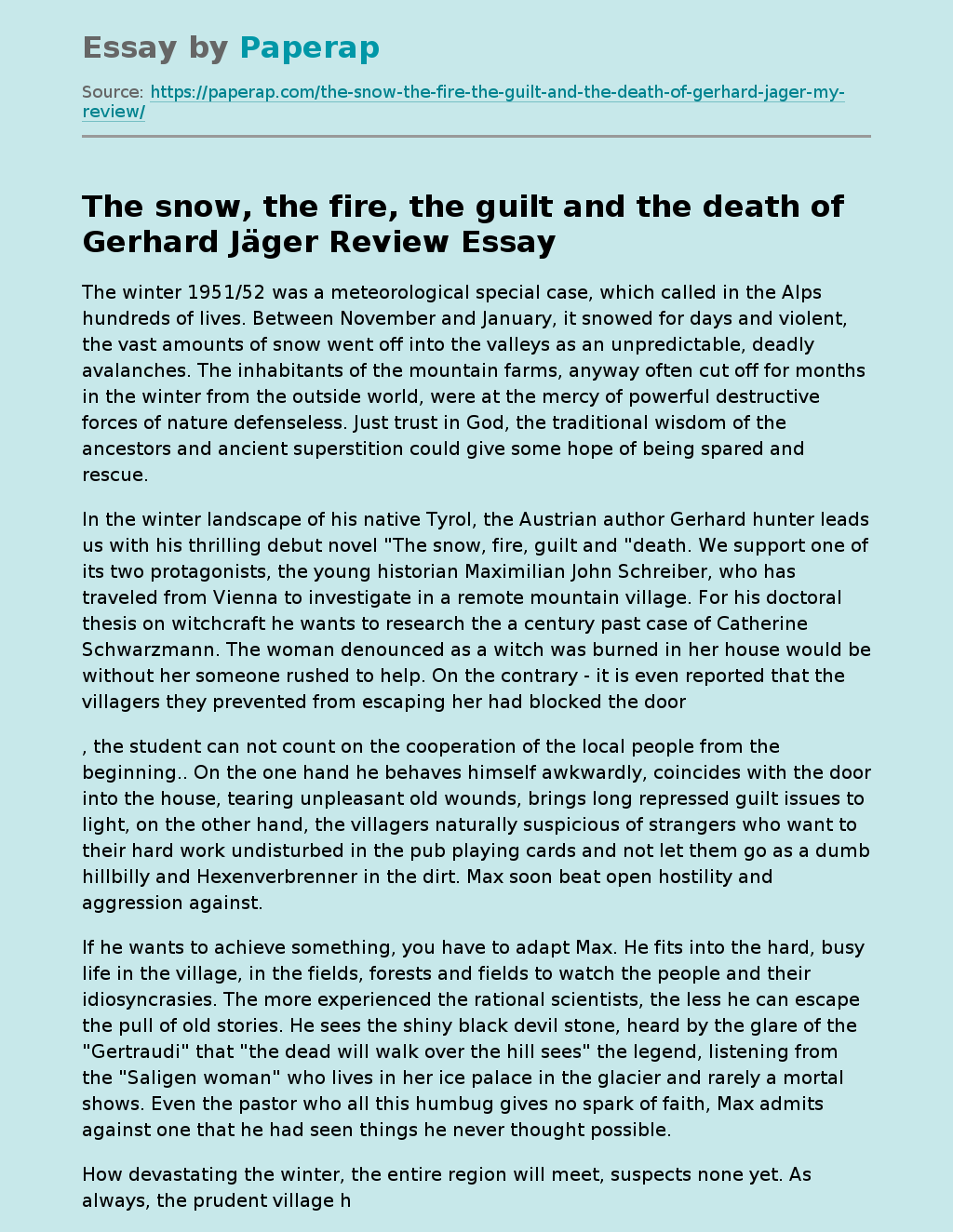The following example essay on “The snow, the fire, the guilt and the death of Gerhard Jäger” is an analysis of the novel. The article reveals the storyline and images of the main characters of the work.
The winter 1951/52 was a meteorological special case, which called in the Alps hundreds of lives. Between November and January, it snowed for days and violent, the vast amounts of snow went off into the valleys as an unpredictable, deadly avalanches. The inhabitants of the mountain farms, anyway often cut off for months in the winter from the outside world, were at the mercy of powerful destructive forces of nature defenseless.
Just trust in God, the traditional wisdom of the ancestors and ancient superstition could give some hope of being spared and rescue.
In the winter landscape of his native Tyrol, the Austrian author Gerhard hunter leads us with his thrilling debut novel “The snow, fire, guilt and “death. We support one of its two protagonists, the young historian Maximilian John Schreiber, who has traveled from Vienna to investigate in a remote mountain village.
For his doctoral thesis on witchcraft he wants to research the a century past case of Catherine Schwarzmann. The woman denounced as a witch was burned in her house would be without her someone rushed to help. On the contrary – it is even reported that the villagers they prevented from escaping her had blocked the door
, the student can not count on the cooperation of the local people from the beginning.
. On the one hand he behaves himself awkwardly, coincides with the door into the house, tearing unpleasant old wounds, brings long repressed guilt issues to light, on the other hand, the villagers naturally suspicious of strangers who want to their hard work undisturbed in the pub playing cards and not let them go as a dumb hillbilly and Hexenverbrenner in the dirt. Max soon beat open hostility and aggression against.
If he wants to achieve something, you have to adapt Max. He fits into the hard, busy life in the village, in the fields, forests and fields to watch the people and their idiosyncrasies. The more experienced the rational scientists, the less he can escape the pull of old stories. He sees the shiny black devil stone, heard by the glare of the “Gertraudi” that “the dead will walk over the hill sees” the legend, listening from the “Saligen woman” who lives in her ice palace in the glacier and rarely a mortal shows. Even the pastor who all this humbug gives no spark of faith, Max admits against one that he had seen things he never thought possible.
How devastating the winter, the entire region will meet, suspects none yet. As always, the prudent village head joins the men in the restaurant on the ratsamen, busy precautions. Max, the outside observers, feel how serious the situation is, and also sees a chance to finally his humiliating reputation as a big-city weakling oppose something manly. He will earn his appreciation, grab, swing the shovel, since ‘on since’ with the strong Tyrolean clear the snow from the access routes and free the roofs of the heavy burdens. An aching back and blisters on your fingers will not stop him.
One day there will be a close encounter in the forest. Between swirling snowflakes a young woman appears, a protective red cloth pulled down over her face and a heavy bag sluggish. A fleeting nod, she disappears again, Max follows her tracks again look in her dark eyes, offers to help when wearing, but she shakes her head vehemently only. Max feels the magic, is electrified, and his yearning for the unknown ousted the consideration to let the backward village behind and return to the comforts of Vienna. Although the mysterious woman remains out of reach for him, it is his destiny to lose up his tracks in the endless white of the snow.
Well, fifty years later John Miller from America looking for the tracks of Max his missing cousin, are still to be found. For then fell in the mountains probably a murder victim. The Provincial Archives in Innsbruck few police files are stored, the majority was destroyed in a fire. After all, John can study the manuscript that Max had put on.
John Miller no less moving CV is the second storyline of this successful alpine homeland novel. The second protagonist comes from Austria. But his beloved wife Rosalind had a soft spot for Indians. Therefore, the two traveled to the example of the Little Bighorn in Montana, where Sitting Bull, the US 7th Cavalry Regiment of General Custer was defeated. Rosalind was killed in a gruesome accident. Twelve years later, it is high time that the now octogenarian widower finally traces the event that lies dormant for decades in the dark: Can he uncover yet the truth about the mysterious death after so many years
The author arranges? the two strands act alternately on its two levels of time, but quite parallel, until they come together. Johns thoughts revolve around his past, as he dips his cousin in the police documents and the manuscript. The latter reported partly in the past, partly in the present tense, says times in the third person, sometimes from the first-person perspective. In the present tense, the narrative tempo increases, the narrator seems rushed, and the reader can hardly escape the dramas of übewältigeden fear of humans, lebenbedroheden Natukatastrphe, the uausweiclichen disaster that overwhelmed the villages.
"The Snow, the Fire, the Guilt and the Death" of Gerhard Jäger. (2019, Nov 18). Retrieved from https://paperap.com/the-snow-the-fire-the-guilt-and-the-death-of-gerhard-jager-my-review/

